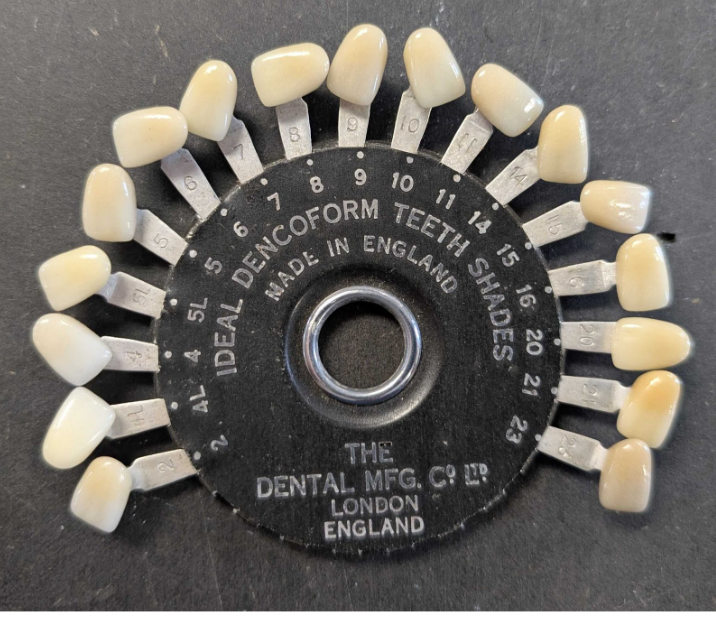
Deep within Nexus Dental Lab's basement, among the carefully archived remnants of the past, we pry open an aged box, its lid groaning under years of dust.
Nestled between antique scales and brass callipers, a peculiar object catches our eye—a black, circular shade guide, its tiny porcelain teeth still gleaming under the dim basement light.
How did this relic of dental history come to be here? And more importantly, what does it reveal about how far we have come?

Their generous donation of this collection to the Ripon City Festival Trust in 1986 has preserved it as an invaluable educational resource.
While the collection is primarily known for its focus on weighing and measuring devices, we have unearthed a surprising gem: an Ideal Dencoform Teeth Shade Guide. This rare dental relic sheds light on the evolution of shade matching.
Holding this relic in our hands reminds us of the remarkable journey shade matching has undertaken. Once an art that relied on the dentist’s intuition and experience, it has transformed into a science of unparalleled precision.
Yet, this discovery from the Renton Collection poignantly reminds us that the path to modern accuracy was paved long ago. To truly understand the innovations that shape our field, we must explore the history of shade selection, evolving from an informed guess to a structured and objective process.
The history of dental shade matching can be traced back to the early 19th century, with significant contributions from Giuseppangelo Fonzi, an Italian dentist residing in Paris.
Fonzi developed terrometallic teeth, artificial ceramic crowns embedded with platinum hooks that could be implanted directly into the socket. Among his most notable achievements was his ability to produce up to 26 different ceramic shades, enabling more natural-looking dental restorations.
His innovation marked one of the earliest intentional efforts to standardise shade selection, laying the groundwork for future advancements.
However, before the widespread adoption of acrylic resin in dentures during the 1940s, dental restorations relied on diverse materials, such as gold wire, human teeth, ivory, and even carved wood. Due to the variety of these materials, shade matching was often an afterthought—restorations prioritised functionality over aesthetics.
By the late 19th and early 20th centuries, porcelain teeth became the standard, and ceramists began hand-mixing porcelain shades to better match natural dentition.
These early methods required skill and artistry, as dental professionals depended on observation, experience, and natural light to choose the closest shade. However, this approach was far from precise—shade perception could shift dramatically under varying lighting conditions, resulting in inconsistencies in aesthetic outcomes.
As dentistry evolved, so did the need for a structured approach to shade selection. Manufacturers introduced basic shade guides in the early 20th century to help clinicians achieve consistent results. These early guides were rudimentary, offering only a limited selection of shades, and they were still highly dependent on the dentist’s judgment.
Enter the Ideal Dencoform Teeth Shade Guide, a tool that brought a new level of uniformity to shade selection. Produced by The Dental Mfg Co. Ltd in 1938, this model provided dentists with a predefined set of tooth shades, enabling greater consistency in prosthetic work.
This was a breakthrough for its time, representing a significant advancement toward a more structured and objective approach to shade matching. However, even with these early tools, shade selection remained a subjective process, heavily influenced by light sources, material translucency, and individual perception.
Another significant milestone took place in the 1930s when Dentsply introduced the Trubyte Bioform System, which included one of the earliest standardised shade-matching systems
This guide classified shades by age groups and gender, a method that has since fallen out of favour. Nevertheless, it set a precedent for future developments and innovations.
In 1956, Vita Zahnfabrik introduced the Vita Classical Shade Guide (A1-D4 system), which became the dominant global standard.
Unlike its predecessors, this system systematically categorised tooth shades, utilising alphanumeric labels (A1-D4) to create a universal language for shade matching.
Dentists worldwide could communicate colour selections using a standard reference for the first time, ensuring more reliable restorations.
Although this method reduced variability, it was not without flaws. The human eye remained the ultimate judge of colour selection, and even in controlled lighting, subtle environmental factors could still lead to shade mismatches.
The Rise of Digital Precision in Shade Matching
As technology has advanced, digital tools have begun to supplant human perception. The invention of spectrophotometers introduced an entirely new method for shade matching, relying on scientific light measurement rather than subjective observation. Although spectrophotometers were introduced in the early 2000s, their adoption has been slow due to high costs and complexity.
Today, numerous laboratories continue to utilise a hybrid approach, blending digital readings with human verification to achieve optimal accuracy. This leads to fewer errors and aesthetic perfection for patients—their restorations are not only similar in colour but indistinguishable from their natural teeth.
As we gaze into the future, shade matching will become progressively dynamic, with the potential for:
As technology advances rapidly, one thing remains constant: the pursuit of accuracy in dental aesthetics.
While sorting through the Renton Collection, we never expected to find a dental artefact hidden among centuries of measuring instruments.
Yet, in many respects, it makes perfect sense. Dentistry's history encompasses the history of measurement, precision, and the pursuit of accuracy—values that still define our work today.
Every innovation, whether a 1930s shade guide or a futuristic AI-powered scanner yet to be developed, builds upon the past. It is a continuous journey towards better, more reliable, and patient-centred dentistry.
While the Renton Collection is securely stored, its lessons endure in every crown, veneer, and restoration crafted by dental labs worldwide.
Ultimately, the past not only informs the future—it shapes it.